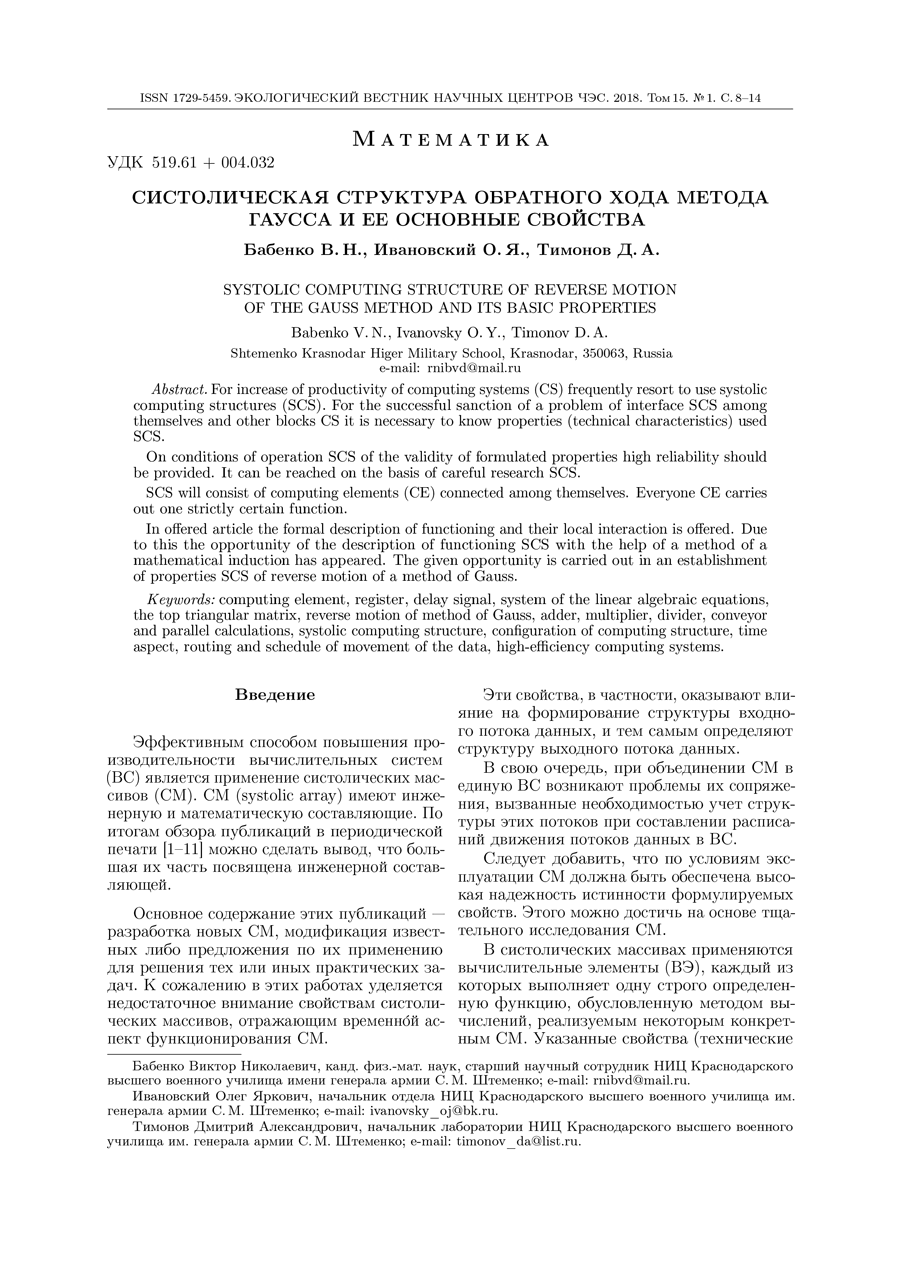Systolic computing structure of reverse motion of the Gauss method and its basic properties
UDC
519.61 + 004.032DOI:
https://doi.org/10.31429/vestnik-15-1-8-14Abstract
For increase of productivity of computing systems (CS) frequently resort to use systolic computing structures (SCS). For the successful sanction of a problem of interface SCS among themselves and other blocks CS it is necessary to know properties (technical characteristics) used SCS. On conditions of operation SCS of the validity of formulated properties high reliability should be provided. It can be reached on the basis of careful research SCS. SCS will consist of computing elements (CE) connected among themselves. Everyone CE carries out one strictly certain function. In offered article the formal description of functioning and their local interaction is offered. Due to this the opportunity of the description of functioning SCS with the help of a method of a mathematical induction has appeared. The given opportunity is carried out in an establishment of properties SCS of reverse motion of a method of Gauss.
Keywords:
computing element, register, delay signal, system of the linear algebraic equations, top triangular matrix, reverse motion of method of Gauss, adder, multiplier, divider, conveyor and parallel calculations, systolic computing structure, configuration of computing structure, time aspect, routing and schedule of movement of the data, high-efficiency computing systemsReferences
- Elfimova, L.D. The combined cellular matrix multiplication method. Kibernetika i sistemny analiz [Cybernetics and systems analysis], 2013, vol. 49, no. 5, pp. 28-37. (In Russian)
- Elfimova, L.D. Fast algorithms for the basic operation of cellular methods of linear algebra. Kibernetika i sistemny analiz [Cybernetics and systems analysis], 2015, vol. 51, no. 6, pp. 35-45. (In Russian)
- Gorjushkina, A.E., Semenov, S.G. The use of a systolic system based on the method of moments for the improvement of the discrete Hartley transform. Zbiryk naukovyh prac' Har'kivs'kogo universitetu Povitrjanyh Sil [Collection of scientific works of Kharkov University of Air Forces], 2016, iss. 1, pp. 89-92. (In Russian)
- Randjelovic, B.M., Milovanovic, E.I., Milovanovic, I.Z. Systolic algorithms for matrix multiplication on space optimal one-dimensional systolic Arrays. Facta Universitatis (Nis) Ser. Math. Infor., 2014, vol. 29, no. 3, pp. 243-259.
- Abdollahi, M.M., Tehrani, M. Designing a novel reversible systolic array using QCA. Italian journal of science & engineering, 2017, vol. 1, no. 3, pp. 158-166. doi: 10.28991/ijse-01118
- Wang, N.-C., Biglieri, E., Yao, K. Systolic arrays for lattice-reduction-aided MIMO detection. J. of Communications and Networks, 2011, vol. 1, pp. 1-13.
- Guo, X., Wang, H., Devabhaktuni, V. A systolic array-based FPGA parallel architecture for the BLAST algorithm. ISRN Bioinformatics, 2012, vol. 2012, Article ID 195658, 11 p. doi: 10.5402/2012/195658
- Bekakos, M.P., Milovanovic, I.Z., Tokic, T.I., Dolic'anin, C.B., Milovanovic, E.I. Selecting Mathematical Method for Systolic Processing. Scientific publications of the state university of novi pazar, ser. A: Appl. Math. Inform. And Mech., 2011, vol. 3, no. 1, pp. 53-58.
- Craciun, S., Brockmeier, A.J., George, A.D., Lam, H., Principe, J.C. An information-theoretic approach to motor action decoding with a reconfigurable parallel architecture. Conf. Proc. IEEE Eng. Med. Biol. Soc., 2011. doi: 10.1109/IEMBS.2011.6091144
- Azimian, A., Dehkordi, A.K., Tehrani, M. A novel systolic array architecture for matrix multiplication circuit design using carbon nanotube technology. Int. J. of Computer Applications, 2017, vol. 172, no. 6, pp. 1-4.
- Causapruno, G., Riente, F., Turvani, G., Vacca, M., Massimo, R.R., Zamboni, M., Graziano, M. Reconfigurable systolic array: from architecture to physical design for NML. IEEE Transactions On Very Large Scale Integration (VLSI) Systems, 2016, vol. 24, no. 11, pp. 3208-3217. doi: 10.1109/TVLSI.2016.2547422
- Gun, S., Uaythaus, H., Kaylat, T. (eds.) VSLI and Modern Signal Processing. Radio i svyaz, Moscow, 1989. (In Russian)
- Kalyaev, I.A., Levin, I.I. et al. Reconfigurable multicopy computing structures. Izdatel'stvo UNC RAN, Rostov-on-Don, 2008. (In Russian)
- Voevodin, V.V. Mathematical models of methods in parallel processes. Nauka, Moscow, 1986. (In Russian)
Downloads
Submitted
Published
How to Cite
Copyright (c) 2018 Babenko V.N., Ivanovsky O.Ya., Timonov D.A.

This work is licensed under a Creative Commons Attribution 4.0 International License.




